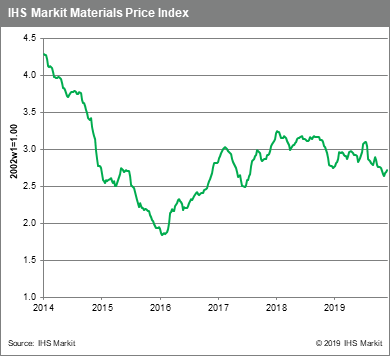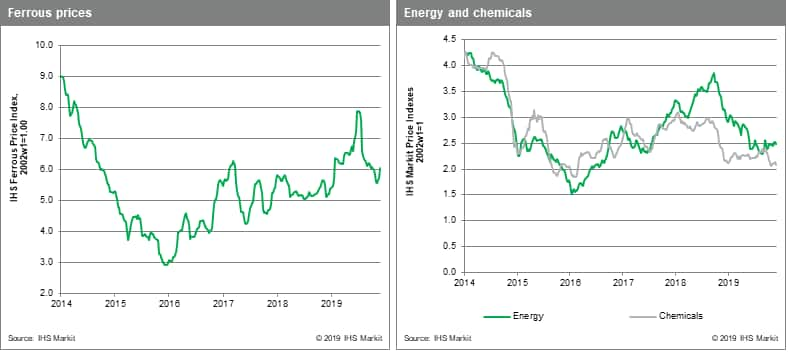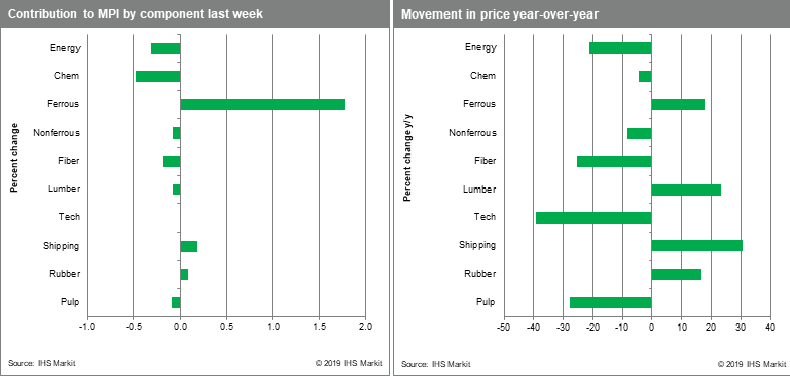Customer Logins
Obtain the data you need to make the most informed decisions by accessing our extensive portfolio of information, analytics, and expertise. Sign in to the product or service center of your choice.
Customer Logins
BLOG
Dec 11, 2019
Weekly Pricing Pulse: The case builds for higher commodity prices
Commodity prices, as measured by our Materials Price Index (MPI), rose 0.8% last week, despite six of the index's ten components falling. Although the week was turbulent, with gains in the commodity complex narrow, sentiment does seem to be improving keyed to more signs that global manufacturing has turned a corner.

Within the MPI, the ferrous index rose 5.0%, supported by large gains in both iron ore and scrap. Scrap increased 9.4% as recovering steel prices and low scrap inventories in Turkey and the US boosted prices. Iron ore also felt the benefit of strong finished steel price gains, rising 4.0% last week on a firming demand outlook and a fall in port stocks. Freight prices also rose 4.0%, driven by the same factors as iron ore. Rubber prices increased 2.9% bringing the recent rally to 14.8% on falling inventory in South-East Asia. The hotly anticipated OPEC "plus" meeting that saw the cartel debate additional supply cuts was not enough to offset early week across the board softness in energy markets: coal fell 1.7%, oil was down 1.0% and natural gas prices, as measured in the MPI, dropped 5.4%. Non-ferrous prices fell 0.9%, led by a freefalling nickel, which averaged $13,409 per metric ton, down from over $18,000 as recently as October 11.

The good news for commodity markets last week came from multiple sources. November's Purchasing Manager Index report showed global manufacturing activity expanding for the first time since May. The US November employment report came in above expectations provided a reminder that the US economy remains resilient in the face of policy uncertainties. While fresh data for the past month has provided some early holiday cheer, important unknowns remain, one of which looms this week with the general election in the UK. A clear election result may begin to provide some clarity on Brexit, which if combined with even a partial US-China trade deal, would provide markets with some positive momentum for early 2020.

{"items" : [
{"name":"share","enabled":true,"desc":"<strong>Share</strong>","mobdesc":"Share","options":[ {"name":"facebook","url":"https://www.facebook.com/sharer.php?u=http%3a%2f%2fprod.azure.ihsmarkit.com%2fmarketintelligence%2fen%2fmi%2fresearch-analysis%2fweekly-pricing-pulse-the-case-builds-for-higher-commodity-pric.html","enabled":true},{"name":"twitter","url":"https://twitter.com/intent/tweet?url=http%3a%2f%2fprod.azure.ihsmarkit.com%2fmarketintelligence%2fen%2fmi%2fresearch-analysis%2fweekly-pricing-pulse-the-case-builds-for-higher-commodity-pric.html&text=Weekly+Pricing+Pulse%3a+The+case+builds+for+higher+commodity+prices+%7c+S%26P+Global+","enabled":true},{"name":"linkedin","url":"https://www.linkedin.com/sharing/share-offsite/?url=http%3a%2f%2fprod.azure.ihsmarkit.com%2fmarketintelligence%2fen%2fmi%2fresearch-analysis%2fweekly-pricing-pulse-the-case-builds-for-higher-commodity-pric.html","enabled":true},{"name":"email","url":"?subject=Weekly Pricing Pulse: The case builds for higher commodity prices | S&P Global &body=http%3a%2f%2fprod.azure.ihsmarkit.com%2fmarketintelligence%2fen%2fmi%2fresearch-analysis%2fweekly-pricing-pulse-the-case-builds-for-higher-commodity-pric.html","enabled":true},{"name":"whatsapp","url":"https://api.whatsapp.com/send?text=Weekly+Pricing+Pulse%3a+The+case+builds+for+higher+commodity+prices+%7c+S%26P+Global+ http%3a%2f%2fprod.azure.ihsmarkit.com%2fmarketintelligence%2fen%2fmi%2fresearch-analysis%2fweekly-pricing-pulse-the-case-builds-for-higher-commodity-pric.html","enabled":true}]}, {"name":"rtt","enabled":true,"mobdesc":"Top"}
]}



